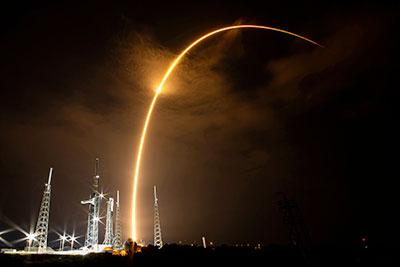|
|

|
|
Author
|
Topic: SpaceX second stage failure on Starlink launch
|
Robert Pearlman
Editor Posts: 52806
From: Houston, TX
Registered: Nov 1999
|
 posted 07-12-2024 01:50 AM
posted 07-12-2024 01:50 AM
   
SpaceX release July 11, 2024 Starlink MissionDuring tonight's [July 11] Falcon 9 launch of Starlink from Space Launch Complex 4 East at Vandenberg Space Force Base in California, the second stage engine did not complete its second burn. As a result, the Starlink satellites were deployed into a lower than intended orbit. SpaceX has made contact with five of the satellites so far and is attempting to have them raise orbit using their ion thrusters. Elon Musk said that the second stage Merlin engine suffered a rapid unscheduled disassembly (RUD), or explosion. Upper stage restart to raise perigee resulted in an engine RUD for reasons currently unknown. Team is reviewing data tonight to understand root cause. Musk said the company's attempts to save the Starlink satellites (Group 9-3) "will probably not work. The satellite thrusters need to raise orbit faster than atmospheric drag pulls them down or they burn up."The engine failure occurred after SpaceX ended its webcast of the launch. For Starlink launches, the company routinely ends coverage after the Falcon 9's first stage is recovered and reports the result of the second stage on social media. Footage of the second stage during its first burn showed an unusual build up of ice but whether that was related to the problem that later resulted in the loss of the engine is unknown.  
|
issman1
Member Posts: 1127
From: UK
Registered: Apr 2005
|
 posted 07-12-2024 02:15 AM
posted 07-12-2024 02:15 AM
  
If I remember correctly, the Falcon 9 upper stage is only burned within the first 10 minutes of a cargo resupply or crew rotation to ISS. So it would not necessarily have endangered any of those missions.But I assume this is not good for Polaris Dawn? |
Robert Pearlman
Editor Posts: 52806
From: Houston, TX
Registered: Nov 1999
|
 posted 07-12-2024 10:19 AM
posted 07-12-2024 10:19 AM
   
Federal Aviation Administration (FAA) statement The FAA is aware an anomaly occurred during the SpaceX Starlink Group 9-3 mission that launched from Vandenberg Space Force Base in California on July 11. The incident involved the failure of the upper stage rocket while it was in space. No public injuries or public property damage have been reported. The FAA is requiring an investigation.Background An investigation is designed to further enhance public safety, determine the root cause of the event, and identify corrective actions to avoid it from happening again. The FAA will be involved in every step of the investigation process and must approve SpaceX's final report, including any corrective actions. A return to flight is based on the FAA determining that any system, process, or procedure related to the mishap does not affect public safety. In addition, SpaceX may need to request and receive approval from the FAA to modify its license that incorporates any corrective actions and meet all other licensing requirements. |
Robert Pearlman
Editor Posts: 52806
From: Houston, TX
Registered: Nov 1999
|
 posted 07-12-2024 05:39 PM
posted 07-12-2024 05:39 PM
   
NASA statement Although the SpaceX Starlink launch was a fully commercial mission, NASA receives insight from SpaceX on all items of interest about the Falcon 9 rocket, as part of the agency's standard fleet following activities. Crew safety and mission assurance are top priorities for NASA. SpaceX has been forthcoming with information and is including NASA in the company's ongoing anomaly investigation to understand the issue and path forward. NASA will provide updates on agency missions including potential schedule impacts, if any, as more information becomes available. |
SpaceAngel
Member Posts: 489
From: Maryland
Registered: May 2010
|
 posted 07-15-2024 10:33 AM
posted 07-15-2024 10:33 AM
   
How will this launch failure impact with future SpaceX mission as well as manned Dragon flights to the ISS? |
Robert Pearlman
Editor Posts: 52806
From: Houston, TX
Registered: Nov 1999
|
 posted 07-15-2024 10:52 AM
posted 07-15-2024 10:52 AM
   
The FAA will not issue a launch license to SpaceX until the cause is understood and the correction is made. Until then, all Falcon 9 flights are on hold, but what that means to the existing schedule for NASA and Polaris Dawn is not yet known. |
Robert Pearlman
Editor Posts: 52806
From: Houston, TX
Registered: Nov 1999
|
 posted 07-25-2024 06:23 PM
posted 07-25-2024 06:23 PM
   
SpaceX says it is "poised to rapidly return to flight" as soon as Saturday (July 27).SpaceX release Falcon 9 returns to flightSpaceX submitted its mishap report to the Federal Aviation Administration (FAA) regarding Falcon 9's launch anomaly on July 11, 2024. SpaceX's investigation team, with oversight from the FAA, was able to identify the most probable cause of the mishap and associated corrective actions to ensure the success of future missions. Post-flight data reviews confirmed Falcon 9's first stage booster performed nominally through ascent, stage separation, and a successful droneship landing. During the first burn of Falcon 9's second stage engine, a liquid oxygen leak developed within the insulation around the upper stage engine. The cause of the leak was identified as a crack in a sense line for a pressure sensor attached to the vehicle's oxygen system. This line cracked due to fatigue caused by high loading from engine vibration and looseness in the clamp that normally constrains the line. Despite the leak, the second stage engine continued to operate through the duration of its first burn, and completed its engine shutdown, where it entered the coast phase of the mission in the intended elliptical parking orbit. A second burn of the upper stage engine was planned to circularize the orbit ahead of satellite deployment. However, the liquid oxygen leak on the upper stage led to the excessive cooling of engine components, most importantly those associated with delivery of ignition fluid to the engine. As a result, the engine experienced a hard start rather than a controlled burn, which damaged the engine hardware and caused the upper stage to subsequently lose attitude control. Even so, the second stage continued to operate as designed, deploying the Starlink satellites and successfully completing stage passivation, a process of venting down stored energy on the stage, which occurs at the conclusion of every Falcon mission. Following deployment, the Starlink team made contact with 10 of the satellites to send early burn commands in an attempt to raise their altitude. Unfortunately, the satellites were in an enormously high-drag environment with a very low perigee of only 135 km above the Earth. As a result, all 20 Starlink satellites from this launch re-entered the Earth's atmosphere. By design, Starlink satellites fully demise upon reentry, posing no threat to public safety. To-date, no debris has been reported after the successful deorbit of Starlink satellites. SpaceX engineering teams have performed a comprehensive and thorough review of all SpaceX vehicles and ground systems to ensure we are putting our best foot forward as we return to flight. For near term Falcon launches, the failed sense line and sensor on the second stage engine will be removed. The sensor is not used by the flight safety system and can be covered by alternate sensors already present on the engine. The design change has been tested at SpaceX's rocket development facility in McGregor, Texas, with enhanced qualification analysis and oversight by the FAA and involvement from the SpaceX investigation team. An additional qualification review, inspection, and scrub of all sense lines and clamps on the active booster fleet led to a proactive replacement in select locations. Safety and reliability are at the core of SpaceX's operations. It would not have been possible to achieve our current cadence without this focus, and thanks to the pace we've been able to launch, we're able to gather unprecedented levels of flight data and are poised to rapidly return to flight, safely and with increased reliability. Our missions are of critical importance - safely carrying astronauts, customer payloads, and thousands of Starlink satellites to orbit - and they rely on the Falcon family of rockets being one of the most reliable in the world. We thank the FAA and our customers for their ongoing work and support. |
Robert Pearlman
Editor Posts: 52806
From: Houston, TX
Registered: Nov 1999
|
 posted 07-25-2024 06:58 PM
posted 07-25-2024 06:58 PM
   
Federal Aviation Administration (FAA) statement After a comprehensive review, the FAA determined no public safety issues were involved in the anomaly that occurred during the SpaceX Starlink Group 9-3 launch on July 11. This public safety determination means the Falcon 9 vehicle may return to flight operations while the overall investigation remains open, provided all other license requirements are met.Background When a public safety determination request is received, the agency evaluates safety-critical systems, the nature and consequences of the anomaly, the adequacy of existing flight safety analysis, safety organization performance, and environmental factors. If the FAA agrees no public safety issues were involved, the vehicle may return to flight while the investigation remains open, provided all other license requirements are met. SpaceX made the public safety determination request on July 15. The FAA gave approval for the Falcon 9 to return to flight on July 25. |
Robert Pearlman
Editor Posts: 52806
From: Houston, TX
Registered: Nov 1999
|
 posted 07-27-2024 10:24 AM
posted 07-27-2024 10:24 AM
   
SpaceX release Starlink MissionOn Saturday, July 27 at 1:45 a.m. ET, Falcon 9 launched 23 Starlink satellites to low-Earth orbit from Launch Complex 39A (LC-39A) at NASA’s Kennedy Space Center in Florida. This was the 17th flight for the first stage booster supporting this mission, which previously launched CRS-24, Eutelsat HOTBIRD 13F, OneWeb 1, SES-18 and SES-19, and now 13 Starlink missions. Falcon 9’s upper stage completed its second engine burn to place it in the final orbit, where all 23 Starlink satellites were deployed.  | |
Contact Us | The Source for Space History & Artifacts
Copyright 1999-2024 collectSPACE. All rights reserved.

Ultimate Bulletin Board 5.47a
|
|

|
 advertisement advertisement

|














